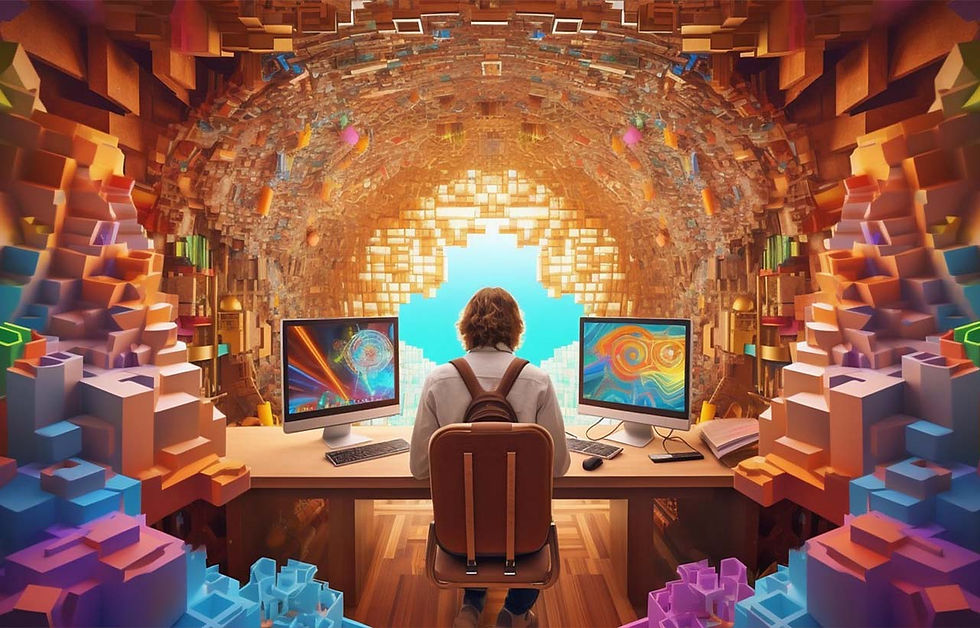Predicting the Future of Color Games with Generative AI
- dukeanna555
- Apr 30
- 3 min read
Updated: May 7

Generative AI is revolutionizing the gaming industry by introducing innovative possibilities and transformative tools. Color games, a genre characterized by vibrant visuals and intuitive mechanics, are uniquely positioned to leverage the capabilities of generative AI. From enhancing gameplay to personalizing user experiences, this technology promises to shape the future of color games in exciting ways. This article explores how generative AI is driving the evolution of color games and the potential impact on players and developers alike.
Dynamic and Adaptive Game Design
Generative AI empowers developers to create dynamic and adaptive game designs that respond to player behavior in real time. In color games, this means generating unique puzzles, challenges, and patterns based on individual player preferences and performance. For instance, AI algorithms can analyze a player's skill level and generate increasingly complex color sequences to keep them engaged and challenged.
This adaptability also enables replayability, as players can experience fresh content and new challenges every time they play. Generative AI ensures that color games remain dynamic and personalized, enhancing long-term player retention and enjoyment.
Creating Unique Visual and Audio Experiences
The vibrant and immersive nature of color games relies heavily on visual and auditory elements. Generative AI can produce unique and sophisticated visuals, generating color palettes, transitions, and animations that evolve dynamically throughout gameplay. AI-generated designs allow for stunning and fluid visuals that captivate players and enhance the aesthetic appeal of games.
Audio is equally impactful in shaping the gaming experience. AI-powered sound design can create adaptive soundtracks that change based on player actions, mood, or game progress. This integration of generative visuals and audio creates a multisensory experience that keeps players fully immersed in the game world.
Enabling Procedural Content Creation
Procedural content creation, driven by generative AI, is transforming how developers build game environments and mechanics. Color games can utilize AI to generate puzzles, levels, and challenges algorithmically, ensuring that content is never repetitive or predictable. For example, AI can create color sequences with unique patterns and probabilities, offering players a variety of gameplay experiences.
Procedural content creation also reduces development time and costs by automating repetitive tasks. Developers can focus on refining the game's core mechanics and aesthetics while relying on AI to populate the game with diverse and engaging content.
Personalizing Player Experiences
One of the most promising applications of generative AI in color games is the ability to personalize player experiences. AI algorithms can analyze player data, such as preferences, playstyles, and interactions, to tailor gameplay elements accordingly. For example, a player who enjoys fast-paced challenges can be presented with quick-response tasks, while a more strategic player might encounter puzzles requiring deeper analysis.
Personalization extends beyond gameplay mechanics. Generative AI can customize user interfaces, color themes, and rewards based on player preferences, creating a unique and engaging experience for each individual. This personalization fosters a deeper connection between players and the game, driving satisfaction and loyalty.
Enhancing Accessibility and Inclusivity
Generative AI has the potential to make color games more accessible and inclusive. AI-powered tools can adapt color palettes to accommodate players with color blindness or other visual impairments, ensuring that everyone can enjoy the game. Similarly, adaptive difficulty levels can cater to players of varying skill levels, making the game approachable for beginners while remaining challenging for experts.
Additionally, generative AI can support localization by generating text, audio, and visuals that resonate with players from different cultural backgrounds. This inclusivity expands the reach of color games, creating opportunities for global engagement and success.
Fostering Creative Collaboration
Generative AI is not just a tool for developers—it can also empower players to become co-creators. Color games can incorporate AI features that allow players to design their own levels, challenges, or visual themes, which can then be shared with the community. By fostering creative collaboration, generative AI transforms color games into platforms like lottery7 login for artistic expression and interaction.
Community-driven content creation enhances player engagement and adds value to the game, as players contribute unique and diverse experiences. This collaborative approach ensures that color games evolve continuously, driven by both developer innovation and player creativity.
Conclusion
Generative AI is reshaping the landscape of color games, enabling dynamic design, procedural content creation, personalization, accessibility, and collaboration. Its ability to create adaptive and visually stunning experiences ensures that color games remain engaging and relevant in an ever-changing gaming industry. As generative AI continues to advance, the possibilities for innovation in color games are virtually limitless, promising a future where creativity and technology unite to deliver unparalleled gaming experiences. Developers and players alike stand to benefit from this evolution, as color games reach new heights of immersion, inclusivity, and personalization.





























TS77CASINO
TS77CASINO
TS77CASINO
Link Situs Slot
Slot Online
Situs Online
slot gacor
slot toto
toto slot
ts77casino toto
ts77casino slot
ts77casino login
ts77casino baru
situs gacor
situs toto macau
slot gacor
situs judi online
aceh4d login
situs judi
slot online
slot toto
situs slot
slot gacor
bandar togel
situs toto
slot toto
slot gacor
situs toto
slot toto
aceh4d
aceh4d
slot maxwin
bacan4d bacan4d login ts77casino bacansports bacansport
bacan4d
bacan4d
slot gacor
slot gacor
situs toto
situs toto
toto slot
aceh4d
aceh4d
aceh4d
aceh4d
aceh4d
aceh4d
aceh4d
aceh4d
aceh4d
aceh4d
aceh4d
aceh4d
aceh4d
aceh4d
aceh4d
aceh4d
aceh4d
aceh4d
aceh4d
aceh4d
aceh4d
aceh4d
aceh4d
aceh4d
aceh4d
aceh4d
aceh4d